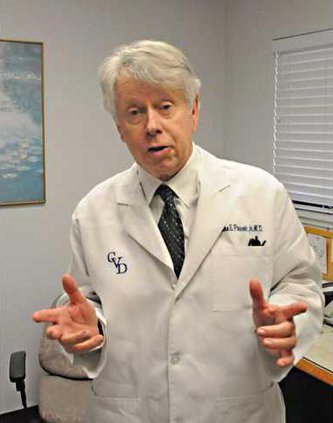Manteca’s only dermatologist Clinton Prescott, Jr., M. D., openly welcomes competition from other skin specialists due to the volume of patients he sees in his practice during a given week at his Central Valley Dermatology practice near Doctors Hospital.
Prescott said from the time he first saw patients in his specialty in 1982 some 42 years ago, the skin cancers contrasting the numbers of lesser skin irritations have reversed. Years ago there would be one cancer out of eight abnormal skin lesions he would discover. Today it’s more like seven cancers or pre-cancers to one benign growth as they are seen increasing by leaps and bounds.
Prescott’s Manteca office is located on the southeast corner of Cottage and North streets across from Doctors Hospital where he has a staff of six in his medical suite. He is affiliated with two hospitals in San Joaquin County – St. Joseph’s in Stockton and Doctors in Manteca.
He first located in the 500 block of East Center Street adjacent to Dr. Melford Larson’s lab facility.
Dr. Prescott attended medical school at the University of Texas Medical Branch at Galveston and graduated in 1972 with a burning interest in all history especially American History, focusing specifically on the annals of the Civil War. It is a topic many of his patients enjoy chatting with him about as a sidebar to their appointments.
“I love all history and I read Patton stories – now it’s the book, ‘Killing Patton’,” he said.
He became interested in medicine as a boy when his mother was a registered nurse and spent much of his after school time playing baseball with some of the doctors’ sons. A Dr. Coleman in Vernon, TX, became his role model, he said.
“I was in the hospital a lot as a boy and I was squeamish about being around blood, but I was told I would get over that,” he said. “And, I did.”
Dr. Prescott said he caught the tail end of Vietnam when many of the refugees were housed at the small Crissy Field next to Letterman Army Hospital near the bay where he served his internship as a medical doctor with the rank of Captain. He said by the time he left the service and going into private practice he had reached the rank of Lieutenant Colonel at Ft. Hood, TX.
When he returned to the Central Valley neither Tracy nor Manteca had a dermatologist. He opened his practice in Manteca serving much of the South County. The practice was slow at first. That practice has grown to the point Dr. Prescott said he needs help. The skin specialist said he now tries to play golf every weekend and had a handicap of 12 some 10 years ago but has managed to get it down to nine.
“You don’t get better if you don’t play more,” he quipped.
Today skin cancer is seen as the most common of all human cancers with some one million Americans across the country diagnosed every year with some form of the disease. Cancer occurs when the normal cells undergo a transformation growing and multiplying beyond the control of the body.
The majority of skin cancers are basal cell carcinomas and squamous cell carcinomas. While malignant they are said to be unlikely to spread to other areas of the body, however they may become disfiguring if not treated early in their growth. Tumors typically overwhelm surrounding tissue by invading their space and robbing the nutrients and oxygen needed to function.
The greatest fear in the skin cancer equation is that of the malignant melanomas – highly aggressive cancers that spread to other parts of the body traveling to other organs through the blood stream.
Medical professionals note that skin cancers start as precancerous lesions – changes in the skin that could evolve into a malignant cancer over time referred to as dysplasia.
These include actinic keratosis as an area of red or brown, rough, scaly skin that may develop into a squamous cell carcinoma. Another is referred to as a nevus mole. Abnormal moles are called dysplastic nevi that can potentially develop into melanoma over a period of time.
Most moles are said to be simply growths that rarely evolve into cancer – with the majority of humans having some 10 to 30 moles on their bodies identified as flat or raised. When one appears different from the others, physicians need to be seen – strongly suggested by the medical profession.




